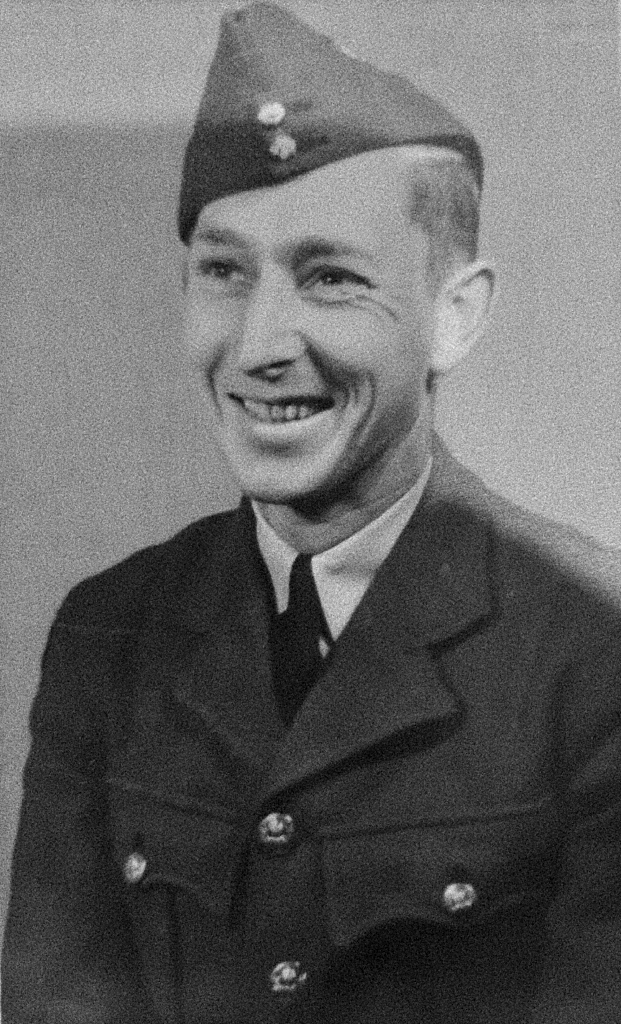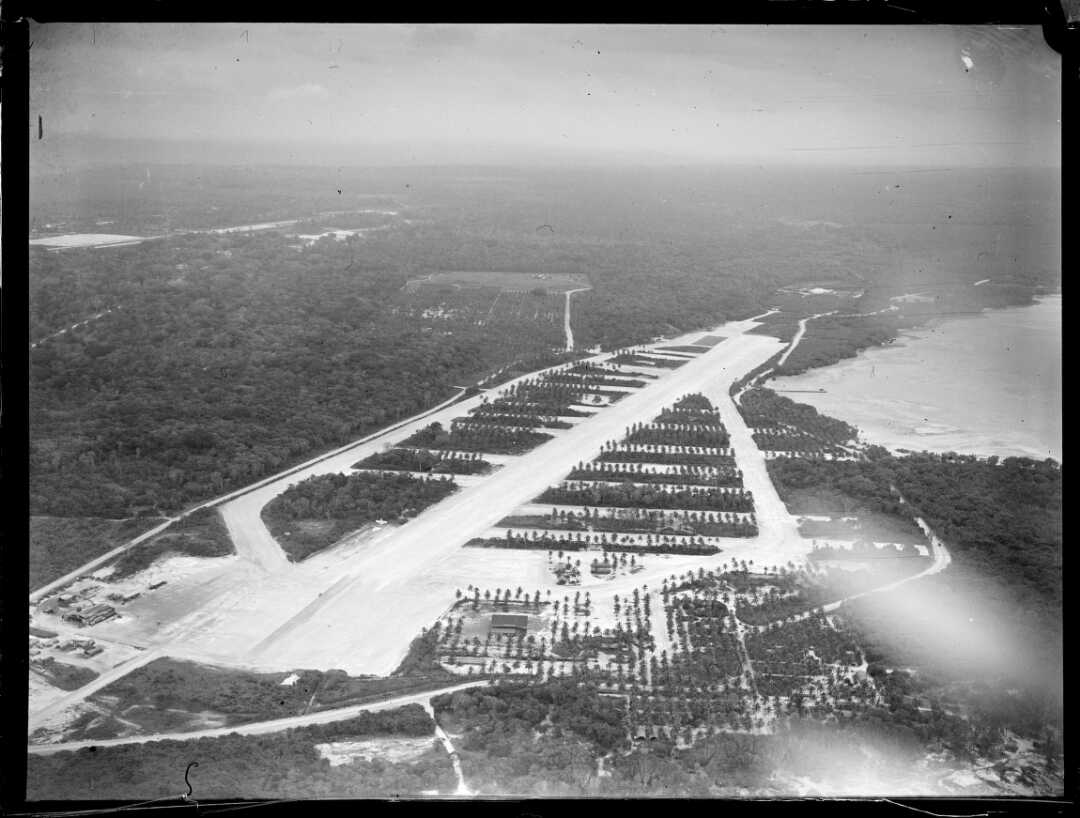AC1 Knud Graae
(1909 - 1963)
Profile
Knud Graae was born in Denmark but he emigrated to New Zealand before the war, where he was naturalised. He served in the Royal New Zealand Air Force from December 1942 to October 1944, including a four months overseas posting in the New Hebrides. He was an active member of the Danish community in Auckland.
Knud Graae was born in 24 February 1909 in Hvidbjerg, the son of pharmacist Knud Børge Graae and Elna Kristine Graae (née Traberg).[1]
Family background
Graae’s father Knud Børge Graae trained as a pharmacist from 1895-1899 and acquired the privilege to run the Thyholm pharmacy in Hvidbjerg in 1904. He went bankrupt in 1908, however, and the pharmacy was handed over to another pharmacist in 1911.[2] According to the family story, he built a cheese factory in Strib, a small town on Funen, in 1909, though the factory never went into production.[3] Graae’s younger sister, Else, was born in February 1910 while the family lived in Strib.[4] A year later, at the birth of his youngest sister Esther, the records states that the father lived in Canada.[5]
He later travelled to the United States, and during the First World War, he was attached to the Letterman General Hospital in San Francisco,[6] which by 1918 was the US Army’s largest general hospital.[7] In December 1914, holding the rank of Sergeant, he was part of a detachment of the U.S. Army Hospital Corps leaving for Manila in the Phillipines.[8] He returned from the Far East in 1921, arriving in Victoria, British Columbia, Canada, from Yokohama, Japan, on 28 November 1921.[9]
Knud Børge Graae returned to China in 1926, continuing his career as a pharmacist in Beijing and in the British Concession of Tientsin.[10]
To China and New Zealand
While Graae’s father was abroad the rest of the family moved to Copenhagen to live with his grandmother. Graae graduated from lower secondary school at Vestre Borgerdyd Skole in 1924. At this point he seems to have moved to China. He worked for Henderson & Co. in Tientsin from 1926 to 1929.
In 1929, he moved to New Zealand arriving on-board SS Ulimaroa on 24 February 1929. He set up a fruit plantation and became co-proprietor of a fruit preservation company, Socro Ltd, in 1930. Another of the owners, Lt Col F. W. Voeleker later recommended him for military service.[11] Leaving the fruit business he worked as a life insurance inspector with T & G Mutual Life Assurance Society until 1943, when he joined the Royal New Zealand Air Force.[12] Graae was naturalised in New Zealand on 17 September 1938.[13]

In RNZAF Service
New Zealand introduced conscription in 1940 as the number of volunteers for military service proved insufficient. All men aged between 19 and 45 were required to register for military service and were called to service by ballot.[14] Graae was included in the ballot notice on 24 June 1942.[15] He applied for enlistment (non-flying) in the trade of clerk (general duties or accounting) in the RNZAF on 4 July 1942.
Graae enlisted in the Royal New Zealand Air Force on 18 December 1942 (NZ.4216403). As many other recruits he was posted to the to RNZAZ Station Levin for ground training. Levin was the Home of the Initial Training Wing at the time. He completed training and was posted to RNZAF Station Hamilton on 13 February 1943.
On 1 May 1943, he was posted to the School of Administrative Training at Levin for instructions in clerk duties. He was re-classified as Aircraftman First Class on 2 June 1943 and returned to Hamilton on the 19th. He remained here until March 1944.
Danish ambulance to the RNZAF
Graae was among the participants, when the Danish Association in New Zealand presented the donation of an ambulance to the Royal New Zealand Air Force on 10 October 1943.

Espiritu Santo
RNZAF fighter squadrons converted from P40s to the faster and more powerful Chance Vought F4U Corsairs during 1944. The aircraft were shipped from the United States and readied for flying by a Corsair Assembly Unit established within the RNZAF Base Depot Workshops at Espiritu Santo (or Santo).[16]
Santo had been transformed since the Americans had first landed on the island, which is part of the archipelago of the New Hebrides. By 1944, the island was well removed from danger of Japanese attacks, but daily patrols were flown to watch for any approaching enemy aircraft or navy vessels.
The south-eastern part of the island had been transformed into a vast military camp, or rather a series of camps, connected by wide, well-grated roads cut through the jungle and the coconut plantations, complete with airstrips, docks, warehouses, hospitals and cinemas.[17]
Santo remained an important part of the RNZAFs Pacific organisation even if its main administrative headquarters had been moved north to Guadalcanal.
 /records/30632365." />
/records/30632365." />The RNZAF Base Depot handled all airborne traffic between New Zealand and the forward area, and served as a staging post and clearing centre for all personnel in transit. Graae was posted to 1 Port Depot in Auckland for overseas posting overseas in 14 March 1944. A month later, 17 April 1944, he was taken on strength at the Base Depot Reception Pool on Santo and four days later, he was posted to the Base Workshops.[18] The work of the unit was described in an Evening Post article in October 1944:
Liberally covered with anti-corrosive dressing, the Corsairs, United States Navy fighters, are carried across the Pacific to this island base as deck cargo. On arrival they are put ashore, and towed along newly-widened roads to the New Zealand assembly flight, where specially-trained teams go to work to fit them for operational duty. Although the aircraft have been test-flown before leaving, the United States they are partly taken down again by the New Zealanders, units are examined, reassembled, and tested before being installed, the anti-corrosive paint is removed, New Zealand roundels painted on to replace the American star, and a number of modifications completed.[19]
Being mustered as clerk, obviously, Graae was not directly involved in the aircraft assembly work, but had a supporting role. The exact function is not clear.
Graae remained at Santo for four months before being posted to Personnel Reception Depot at RNZAF Auckland (Mangere) on 7 August 1944. He was posted to the Maintenance Wing at RNZAF Ardmore on 21 August 1944.
He was discharged on 20 October 1944 on compassionate grounds.[20]
After the war Graae lived in Auckland as a business owner until his death on 1 January 1963.[21] He was an active member of the Danish community in Auckland.[22]
Endnotes
[1] DNA: Parish register, Hvidbjerg Sogn (Thisted).
[2] Schæffer, A. (1929). Den Farmacevtiske Stat i Danmark 1929, p. 30.
[3] Grandjean, P. (1914). Den Graae’ske slægtebog, p. 49.
[4] DNA: Parish register, Vejlby sogn.
[5] DNA: Parish register, Rigshospitalets præsteembede.
[6] Grandjean, P. (1914). Den Graae’ske slægtebog, p. 49.
[7] Letterman Hospital Complex, National Park Service, https://www.nps.gov/prsf/learn/historyculture/letterman-complex.htm (retrieved on 2 October 2022).
[8] Ancestry: U.S., Army Transport Service, Passenger Lists, 1910-1939.
[9] Ancestry: Canadian Passenger Lists, 1865-1935.
[10] Schæffer, A., op.cit., p. 179.
[11] Company Affairs, Auckland Star, Vol. LXI, Issue 65, 18 March 1930.
[12] Kamp, A. (1956). Danske i Udlandet 1956. København: Dansk Samvirke, p. 203-204.
[13] ANZ: R24588054.
[14] Ancestry: New Zealand, World War II Ballot Lists, 1940-1945.
[15] Ancestry: New Zealand, World War II Ballot Lists, 1940-1945.
[16] Ross, J. M. S. (1955). Royal New Zealand Air Force, p. 253.
[17] Ross (1955). op.cit., p. 277.
[18] Service record.
[19] Jungle Workshops, Evening Post, 9 October 1944, Page 6.
[20] Service record.
[21] Ancestry: New Zealand, Cemetery Records, 1800-2007.
[22] Dødsfald, Danmarksposten, May-June 1963.